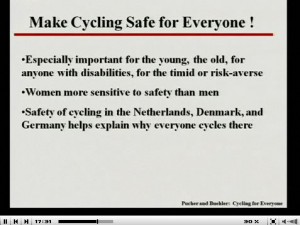Update – We’re super impressed by the comments on this item. We also appreciate the discussion the ‘comment’ format affords. Some people have also emailed me @ cuthash@worldnet.co.nz. You are welcome to do this if you prefer – just keep the ideas flowing, as they are hugely valuable to Cycle Action.
The NZTA is leading a project that could help transform our our road culture and support the huge interest we are seeing in cycling.
The brief is to –
Develop an innovative, comprehensive and practical set of recommendations for how central and local government can ensure that on road cycling is provided for as a safe transport option.
The Agency appointed an impressive team of experts for the job, and has invited a wide range of organizations to act as a reference group. Both groups are meeting in Wellington on 15th April to swap experience and expertise. Cycle Action will be there.
Ideally the project brief would have also referred to recommendations to grow cycling numbers, as we know that is integral to improving cycling safety. But we’re 100% sure this will be embedded in the thinking and advice of most members of the expert panel.
We want to open this process up to the Auckland cycling community – as we’ll be there representing you. To focus the feedback, here are a few questions. A few of Cycle Action’s ‘top of the head’ responses are set out in red, but they’re not comprehensive or innovative. That’s why – we want to hear from you!
- What are the key safety issues that people face cycling to work (on urban, high and low volume rural roads)?
– A road culture where cyclists are not ‘seen’, respected or accepted as valid road users. This is reflected in: a lack of cycle infrastructure in general, particularly lack of protected cycle facilities on faster / busier roads ds with speeds limits inappropriate for safe on-road cycling (50+ km/h); a need for more speed- limited areas, particularly residential areas, town centres, etc.; large / speedy / multi-lane roundabouts, (often very unsafe, even with cycle facilities usually very inconvenient) ;
– Urban: intersection vehicle queues at narrow lanes (roads maximised for cars with many narrow lanes) without cycle lanes force cyclists to wait for same delays as car drivers, or unsafely make their way to front (somehow…) ;
– Car parking is an strategic obstacle and a hazard – resistance to car park removal prevents cycle projects from progressing. Parked cars also present problems of dooring, visibility, creating unexpected pinch points etc…)
- What are the key safety issues that children face cycling to school (on urban, high and low volume rural roads)?
–– lack of safe routes to school and large amount of chaotic traffic (school drop-offs!) near school. Children are small and can be unpredictable – not easily seen and no margin for error in busy road environments; Speed of traffic en-route to school. A culture of fear exists wherein cycling to school is not longer ‘normal’- hence, parents un-supportive / afraid to let their children ride and schools un-supportive, or outright banning cycling to school
- What are the key safety issues for sport and recreational cycling (again on urban, high and low volume rural roads)?
– speed of cycling groups on urban and rural roads makes them more vulnerable to any unexpected incident; speed and scale of truck traffic is incompatible with the light and fast nature of some recreational cycling, lack of shoulders on rural roads gives cyclists nowhere to take refuge when needed; driver resentment towards road cyclists and lack of mutual courtesy creates unsafe road culture;
- Are there safety misconceptions that the public have regarding cycling on New Zealand roads?
– cycling in NZ is too unsafe. It’s true that safety perceptions are major factor preventing more people from cycling. so it needs to be made safer. But it is actually not nearly as deadly as non-cyclists perceive .- Also people perceive urban cycling as less safe than in the countryside. They are surprised when we say that cycling in busy urban areas is actually safer than cycling on “empty” rural roads. (They nod their head when we talk about the impact of the higher speeds in rural areas, the lack of shoulders etc. )
- Are you aware of any specific local cycle safety issues that should be considered in this review (this can include local seasonal issues with winter conditions or holiday traffic etc.)?
– there are severe issues with cycling through motorway interchanges, many of which are badly suited for cycling (but which often have to be traversed due to the severance effect) ; many of the “cycle facilities” on record are actually shared bus lanes, which have significant actual and perceived safety issues; cycling infrastructure is disconnected, poorly maintained (cycle symbols and greening) and poorly designed; there is a lack of priority and protection at intersections and on major cycling routes within the city; the width of many older shared paths is no longer adequate for safe walking and cycling use, increasingly cyclists are requiring separate facilities ; delivery of the cycle improvement programme is behind schedule ie lacking priority in overall transport delivery; the time lag and restricted application of cost effective safety initiatives shows more priority is needed on simple innovations such as flexible barriers; upgrading the cycle programme is not keeping pace with PT upgrades, so safe access and facilities are not meeting the public’s need for safe convenient and affordable transport choice; pepper-potting of safety improvements needs to stop so residential neighbourhoods are connected with slower speeds and walking/cycling priority designs to the arterial protected routes connected across the city.
- Are you aware of any priority or have a recommendation on the priority of the above safety issues?
– protected cycle lanes in urban areas, shoulders in rural areas and reducing speed limits should be the key moves
One of our safety and infrastructure team also made this comment off the top of his head – “There’s nothing new in the questions, so therefore nothing new in our reply – separated infrastructure, wide rural shoulders, improved road user behaviour, calmed suburban streets with lower speed limits, and look overseas to see how well it can be done. No rocket science, just money and commitment! ” – I love the brevity and no-nonsense approach here.
Now it’s over to you!




